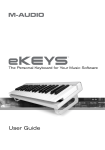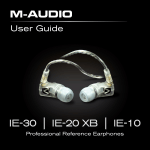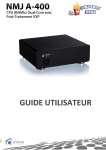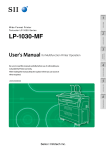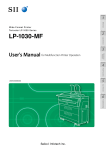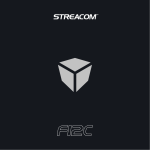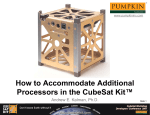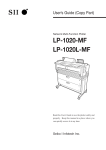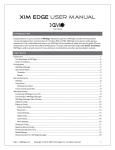Download Home Theater PC: Lessons Learned
Transcript
A PUBLICATION BY MY MEDIA EXPERIENCE HOME THEATER PC: LESSONS LEARNED Things I Wish I Would Have Known Before I Built My First HTPC 2015 EDITION TABLE OF CONTENTS 1. GETTING STARTED 2. GENERAL LESSONS LEARNED 3. HOW TO BUILD A HTPC 4. HOW TO CONFIGURE IT 5. HOW TO SET UP SOFTWARE CHAPTER ONE GETTING STARTED About this eBook Choosing the right hardware and software for your first Home Theater PC (HTPC) can be a difficult process. I wanted to make it easy for you and keep you from wasting your time and your money on tedious research, so I built and tested five reference HTPC builds myself and combined all of the key lessons learned into this compact and practical eBook. If you are looking for some excellent hardware and software tips, this eBook will definitely save your time and money. The content in this eBook is for informational purposes only. You should always seek the advice of a professional before acting on something that I have published or recommended. No part of this publication shall be reproduced, transmitted or sold without the prior consent of the author. I'm the founder of the popular HTPC resource called My Media Experience, founded in 2009. I have over 15 years of experience in building HTPCs. - Tuukka Komssi, Author How to use this eBook I've organized this eBook into chapters and they include one lesson learned on each of the page, so you can easily locate the information that is most relevant to your situation. Chapter 1 is about introducing you to the subject. Chapter 2 is about basic lessons learned on HTPC principles. Chapter 3 is about component selection. Chapter 4 is about configuring and making the most out of it. Chapter 5 is about front-end and back-end software. You will not only find a lot of useful information on each page, but some of the lessons include a link to mymediaexperience.com website, where you will find more relevant and up-to-date information on the particular subject. So, whenever you wish to get more information on the subject, just follow this link: Learn more about this (click here) Introduction A Home Theater Personal Computer, HTPC for short, is a computer connected to your TV that plays local media (movies, music, and photos) and internet media content. If you want to reach the full potential of connected home entertainment, then getting a HTPC is the way to go. HTPC brings most of the home theater devices into one box. HTPCs are often smaller and quieter compared to desktop computers, as they are designed to be used in the living room. The not-so-silent hum of your desktop PC might not be a problem in the office, but it can be a significant annoyance to people in your living room trying to enjoy a movie. What are the benefits of a HTPC? - It reduces the number of home theater devices - It provides a large degree of flexibility - It has a faster user interface - It has custom fanart and metadata for your media - It has large storage capacity for media files - It supports many media formats - It has built in DVR capability In this chapter, I will introduce five reference HTPCs that I currently use in my home: 1 Ultra-cheap HTPC Ultra-cheap HTPC is the most affordable and smallest build that features the Raspberry Pi model B+ board. Raspberry Pi has developed significantly as a media center during the past year and can be now used as an ultra-cheap HTPC. Raspberry Pi is capable of Blu-ray quality playback, using H.264 at 40MBits/s. You can also play MPEG-2 and VC1 video files, but you need to buy a separate license. So, if you are looking for a starter HTPC, this ultra-cheap system is the right choice for you. Learn more about this system 2 Entry HTPC This is a $250 entry-level system that runs completely silent and can be set up in less than an hour. The system is based on a low-cost AMD AM1 Athlon 5350 that runs only at 25W TDP, which means your system will be completely silent. I have chosen a compact Antec ISK 110 case that comes with a fanless power supply. This system is one of the cheapest and easiest ways to build a quiet and capable home theater computer, especially when using OpenELEC operating system Learn more about this system 3 Budget HTPC This budget build is designed to be used with XBMC Media Center (either Windows 8.1 or OpenELEC OS) to watch 1080p HD videos, play music, and view photos. The system is powered by AMD’s A6-6400K Richland CPU, which is a great choice for those looking for good graphics performance without the need for a discrete GPU. The latest AMD Richland generation provides slightly higher clocks and better power management than the previous Trinity platform. Learn more about this system 4 Value HTPC This value HTPC provides the best HD video and 3D Blu-ray performance with an excellent value to price ratio. When using the aftermarket CPU cooler and case fan, this build is practically silent. This is the HTPC at the moment. This system includes an Intel Core i3 processor, which many people regard as the standard in HTPC applications. If you are not planning to play the latest games with your HTPC, you will be fine without a separate graphics card. Learn more about this system 5 Performance HTPC This performance HTPC is a project for building a near silent HTPC that is capable of 1080p gaming. I am using an Intel Core i5-4570S processor, which is a 65W CPU that runs super cool and keeps everything quiet while providing enough performance even for games. I chose a Gigabyte 750 Ti Windforce graphics card, which is an excellent choice for silent running HTPCs whilst offering strong performance. I am using a Silverstone ML07 case, which has an advanced layout designed for maximum performance and a PCI-E riser. Learn more about this system CHAPTER TWO GENERAL LESSONS 6-19 The rule of thumb You already own a camera or smart-phone to take photos. You already own an MP3 player to listen to digital music. You probably watch online videos from YouTube or other services. Why wouldn’t you bring all of this technology into your TV? You might have already heard about home theater computers that allow you to take your media experience to the next level. However, reading online technology discussion forums or visiting a local computer store might feel overwhelming to you, as there are too many products available and you don't necessarily know which products are good values. As I have spent thousands of dollars and countless hours to find out how to build the ultimate media experience, in this chapter I will share the basic lessons learned. “ Getting your HTPC together is a bit different from setting up a regular PC. You should be thinking about power efficiency, form factor size and noise levels. And most importantly, you should be thinking about the user friendliness. 6 Determine your needs Before you proceed in selecting the parts, you should stop and think about how you intend to use your HTPC. Here are few questions you may want to contemplate: - How much are you willing to spend? - Do you want to watch 1080p or 4K videos? - Do you want to watch Blu-ray disc movies? - Do you want to watch live TV? - Do you want to play modern games? You should focus on the key use of your HTPC system, e.g., is it a media server or gaming HTPC. You will need to know this in order to decide on the type of parts you need. 7 Take the time to research There is no rush to build your HTPC, so take the time to carefully research components to make sure they are all compatible with each other. I would suggest assessing carefully all the ”internet forum advice”. There is a lot of good advice out there, but you need to do your own research to find out what you really need and not buy something you will later regret. In case you have no idea what to choose, there are five builds that I have built and tested for a beginner HTPC. While these components are working well, you need to understand basic principles in component selection. 8 Find the right balance Building a home theater computer is about finding the right balance among: - acceptable noise levels - power consumption and performance - the appearance and size of the case - how much you are willing to spend on it Some common considerations when choosing parts are: cost, performance, form factor (size) of parts, power consumption, ease of cooling, storage capacities, driver stability, etc. You should focus on the two often ignored factors, noise and power efficiency. 9 Silence is golden Noise is a very important consideration when choosing parts for your HTPC. The key to a quiet HTPC is to use low power parts such as solid state hard drives, 80 plus certified fanless power supplies, and low power CPUs, which generate less heat and thus require less cooling. The more power efficient components you will use, the less cooling you will need. The less cooling you will need (and the more passively cooled components you will use), the quieter your system will be. In addition, you should invest in high-quality cooling fans. Mini-ITX Micro-ATX ATX 10 Size does matter A form factor means the physical dimensions of the system. In practice, the motherboard form factor defines the size of the case you can use, so choose the case, motherboard, and CPU first. The most popular form factors among HTPC users are ATX, micro ATX, and mini ITX. When considering a case form factor, it is good to keep in mind that smaller mini ITX form factor cases usually have smaller fans, which are louder than the larger ones used in micro ATX cases. A larger case also means that you can have better airflow and room for more hard drives and other peripherals. 11 Focus on low TDP rating A processor, graphics processing unit, and power supply are the main sources generating heat inside a case. When choosing a processor or graphics card, it is advisable to check not only the performance, but also its Thermal Design Power (TDP), which indicates the power consumption of a CPU or graphics card. The TDP describes the maximum amount of power in the cooling system in a HTPC is required to dissipate. You should choose a processor or GPU with a max TDP of no more than 65 watts. The low-power CPU runs at reduced voltages and emits less heat, which requires less cooling. 12 Don't buy the latest parts It is better to wait at least 6 months after the release of new components such as a CPU or graphics card. When I first purchased AMD A6-6400K Richland processor, it was not supported by the latest OpenELEC operating system at that time, but I needed to find a special OpenELEC version that included the necessary drivers. Nowadays, it works flawlessly with the latest versions of OpenELEC. The same happened again, when I first bought an AMD AM1 platform based AMD Athlon 5350 APU. The drivers were not mature enough and I had some occasional freezing before more solid drivers became available. 13 Don't try to future-proof Future-proofing your system is very difficult. You can buy components that will be fine in 3 years, but it is not possible to buy something today that will be really good when you eventually need it. So, if you want to build a HTPC that is ready for the future, unfortunately, the components needed for that are not available today. For example, I would not suggest trying to future-proof your system for the ultra HD 4K resolutions if you don't need that capability today. My advice is to buy the components that you really need today and upgrade or build a new one in the coming years. 14 Check the compatibility When building your first HTPC, you want to know for sure if these parts are compatible. Unfortunately, I’ve faced several compatibility issues building HTPCs. So, be sure to check that - the motherboard supports selected CPU chipset - the size of the PSU is compatible with the case - the PSU is powerful enough for the system - the aftermarket CPU cooler will fit inside the case - the memory cards fit next to the CPU cooler - the graphics card is not too long or tall - the larger capacity 2.5” hard drive fits if the case only supports 2.5” HDDs 15 Store media on NAS I would recommend storing all media files to a separate Network Attached Storage (NAS) or back-end home media server that also does all the heavy lifting such as recording live TV or transcoding video files. Network Attached Storage (NAS) is storage that can be accessed over a home network as opposed to single computer access. In other words, a NAS server allows you to share media between several PCs and other devices. An additional benefit is that NAS servers include multiple HDDs that allow you to back-up and mirror media files. 16 Ditch optical disk drive Nowadays, many people are downloading or streaming digital content from iTunes, Spotify, Netflix, Hulu or by other means from the Internet. If this is the case for you, perhaps you do not even require a DVD or Blu-ray drive. In fact, you do not necessarily need an optical disk drive at all as it is possible to install both Windows and Linux operating systems from a USB drive. In general, it is a good idea to remove the optical disk drive from your HTPC as they use power and are noisy. If you occasionally need to watch DVDs, you can have an external USB DVD drive on hand. 17 Positive air pressure It is a good idea to build positive air pressure flow within the case. Positive air pressure inside your case will make a huge difference in keeping dust out. The case with positive air pressure can prevent dust from penetrating into the case through the use of filters on intake fans and forcing air out of the case through unfiltered vents and gaps. Therefore, intake fans should provide higher combined airflow compared to exhaust fans in order to achieve positive pressure inside the case. Often, the main point is to have the fans nearest to the CPU drawing out air, and the opposites drawing air in. 18 Clear that cable clutter Cable management improves internal airflow by reducing cable clutter to promote accelerated heat removal. In order to reduce the cable clutter, it is recommended to use modular PSUs and cable ties. A modular power supply provides connectors at the power supply end, allowing unused cables to be detached from the power supply. You should also use cable ties that will help you to make your cabling clutter free and thus improve the airflow. Another tip is to run the cables along the edges or under the motherboard. 19 Monitor temperatures Use temperature-monitoring apps such as SpeedFan to ensure you have enough cooling after finishing the build. SpeedFan is a hardware monitoring software that is able to change fan speeds according to system temperatures. In the SpeedFan application, you should look at the Core # for the best temp gauges. The optimal temp is about 5 to 8 degrees C warmer than the ambient temp in the room. You may need to play around with the number of cooling fans, fan speeds and temperature levels over time to find out what nets you the best balance between good temperatures and good noise levels. CHAPTER THREE BUILD IT LESSONS 20-44 Media Streamers If getting a HTPC sounds too complicated for you, another option is to get a media streamer such as Apple TV, Roku or Google Chromecast. These devices allow you to stream content from the Internet and other computers to enjoy videos on TV. They are not as versatile as HTPCs, but as streamers, they are a good alternative. If you want to have more flexibility but still don’t want to build a custom HTPC, then you should consider setting up the very popular Raspberry Pi mini computer or Ouya game console. Both of these little devices allow you to install media center software such as Kodi (was XBMC), which allows you to customize your media experience much more than the commercial media streamers. “ In my opinion, Ouya looks like a very promising alternative to run Kodi (XBMC) thanks to its low cost and excellent performance. However, it does not have as active development community as Raspberry Pi at the moment. 20 Linux-based Raspberry Pi Raspberry Pi is an amazing little computer that can be used as a complete Kodi entertainment center solution. I have written a complete and up-to-date tutorial on how to install and configure Kodi on Raspberry Pi that you can find by clicking the link below. You will learn how to build a HTPC front-end by installing and configuring a Raspberry Pi Kodi distribution called Raspbmc. You will also learn how to optimize Raspbmc to run significantly faster for better user experience. Learn more about Raspberry Pi 21 Android-based Ouya If you are looking for optimal hardware for use as an XBMC media platform, the Android-based Ouya game console is the right choice for you. In a complete guide that you can find by following the link below, I will show you easy and advanced ways to set up XBMC on Android to turn the Ouya game console into the ultimate media box. Ouya is great for anyone who wants an affordable and good media center with the ability to run retro games. Learn more about Ouya 22 Other Android devices Some of My Media Experience readers have been really surprised that I haven't embraced the ready built inexpensive computers such as Amazon Fire TV, Chromebox and other Android boxes as clients. The Ouya game console is the only Android device I currently own, but I have read many positive reviews about Amazon Fire TV running with Kodi (was XBMC). The reason why I have not tested Fire TV is simply because it hasn't been released in the country where I live. However, I would definitely suggest trying out Amazon Fire TV. Learn more about Android boxes Custom HTPCs Nowadays, there are all kinds of small media streamers and smart TVs, so why would you need a HTPC in your living room? Many of my friends view videos through their Xbox, PlayStation or Blu-ray player, yet they had no idea what an HTPC was. After they had seen my home theater PC setup for the first time, they were amazed at what you can do with your TV. The key reason to build your own HTPC is the flexibility and quality. You can have exactly the kind of hardware and user interface you need. An HTPC is only as expensive as you make it. You can build an HTPC for less than 300 dollars. You can even build one using old PC components you might already have. Furthermore, most media center software such as Kodi (was XBMC) or Plex, is entirely free. And, by the way, they look stunning! “ I enjoy using an HTPC in my living room because it is tailored exactly to my family's needs. Favorite TV shows and movies are easily accessible, and even my young children know how to access their own videos from the main menu. 23 Get the right tools When building my latest performance HTPC using Silverstone ML07 case, it was really frustrating attaching the power supply's holder cage back to the case without having a thin magnetized Phillips screwdriver as the screws were in difficult places. So, if you want to save your nerves, I would recommend getting a thin magnetized Phillips screwdriver. Secondly, it is a good idea to have placeholders for all the tiny screws because otherwise you will easily waste time searching for the lost screws. 24 Start with a case It is good to start choosing components with a case. The case size will determine the size of the motherboard you will need. Remember to pick a good quality case. The height of the case will also determine what kind of CPU cooler you can use and whether or not you can use full or half-height graphics or TV tuner cards. There are three common form factors: mini-ITX, micro-ATX and ATX. For HTPC use, the mini-ITX and micro-ATX are preferred and most common sizes. 25 Use a low power CPU Nowadays, integrated graphics processing units inside the processors are powerful enough for HTPC use. Intel Haswell processors are currently the best choice when it comes to performance and power efficiency. The recommended Intel Haswell options are Intel Core i34130T (35W TDP) and Intel Core i5-4570S (65W TDP). If you want to have cheaper alternatives, the recommended AMD APUs are AMD AM1 Athlon 5350 (25W TDP) and AMD A6-6400K (65W TDP). Learn more about HTPC CPUs 26 Compatible motherboard In addition to the processor, the other important purchase you should focus on is the motherboard because it will make or break the performance of all the components that will be attached later. The type of motherboard you choose will depend on the CPU chipset you choose. For Intel Haswell, I would recommend getting H97 or Z97 series motherboards. For AMD Richland, you should get AMD FM2 or the newer FM2+ motherboard. In addition, you should choose a motherboard with at least two connectors for controlling case fans. 27 Get enough SATA ports You should pay attention to the number of SATA ports. Usually, mini-ITX and micro-ATX motherboards include 4 or 6 SATA ports. If you plan to have several HDDs, for example, for a media server, be sure to choose a motherboard that has 6 SATA ports. If you are planning to use an optical drive and multiple hard drives, this is an important consideration for you. For example, when I bought an ASUS AM1I-A mini-ITX motherboard, I realized that it had only two SATA ports, so I was only able to use one hard disk in addition to the optical drive. 28 Use good thermal paste I would recommend applying a good thermal paste such as Arctic Silver 5 and Noctua NT-H1 to the processor as it will help drop the CPU's temperature a couple of degrees. You should use no more than a pea-sized amount and spread it in a thin layer over the entire processor surface. Adding too much thermal paste will slow the transfer of heat, making it more difficult to cool the CPU quickly. Ideally, you should use slightly less thermal paste than the amount shown in the above image. 29 Use a quiet CPU cooler Stock CPU coolers come free with your CPU but are often too noisy for HTPC use. Intel Haswell's S- (power saving) and T- (thin chassis) models have slightly quieter cooling fans, but they still are not on par with the best coolers. I would recommend getting an aftermarket CPU cooler such as Noctua NH-L9A (AMD), NH-L9I (Intel) or Scythe Big Shuriken 2 (AMD or Intel), which are designed to be quiet. It is important to install the aftermarket CPU cooler with the motherboard outside the case as the cooler retention plate mounts underneath the motherboard. 30 Use low voltage RAM The most important thing to remember about memory is to get at least 2 GB for Linux and 4 GB for Windows. The DDR3-1333 MHz and DDR3-1600 MHz RAM memory are supported by most motherboards, and while the 1333 is enough for HTPCs, 1600 is better for overclockers. You should not use memory modules with heatspreaders, especially with larger CPU coolers as they may not fit under the heatsink. You should use lower voltage memory modules as less power consumption means less cooling is required. This will also save on the electric bill. 31 Use low noise case fans Often stock case fans are too noisy, so you should use quality brands such as Noctua 120 mm fans as they move air much efficiently with less noise compared to smaller fans. Dust filters are also great for keeping the HTPC clean. I would recommend getting a fan controller as motherboards often adjust fans to run faster (and louder) than needed. Depending on the case, you will need one to three case fans in addition to a CPU cooler, but it's good to test with stock case fans to discover how many fans you need to reach optimal temperature and air flow. You can also adjust the speed of fans from the BIOS. 32 Use SSD as a boot drive A solid state drive (SSD) is the single best upgrade you can make for an HTPC to improve the speed while making the system quieter. An SSD will make your user interface feel snappier, for example by helping with the loading of 1080p fanarts and other metadata. As an additional benefit, your system will boot and shut down much faster, and the system will just feel much snappier overall. SSDs are really light-weight, so even if your case does not have a slot for it, you can use an adhesive tape to attach it anywhere inside the case. 33 Use media hard drives You should use a standard hard drive for storing media files and recordings since you won’t see any performance gain using an SSD for playing media files. 2-4 TB hard drives are currently optimal sizes in terms of storage and price. Green hard drives that run at slower 5400 RPM speed are a great choice as media hard drives. Keep in mind that the more hard drives you use inside the HTPC case, the more noise and heat they will generate. Please note that HDDs larger than 2TB cannot be recognized properly by older 32-bit versions of Windows, so in order to use 3TB+ HDDs, you should use 64-bit OS. 34 Graphics card for gaming If you are going to get a discrete graphics card for gaming, be sure to check the dimensions of the card and its Thermal Design Power carefully before purchasing. For example, I bought a passive cooled graphics card, but it did not fit inside my case because it was slightly higher than regular cards due to its passive cooling solution. Also, make sure that the power supply you have chosen is powerful enough for the graphics card. For example, I chose 450W SFX PSU for Geforce 750Ti graphics card, which was enough, but PSU's cooling fans were a bit too noisy as it was running too close to its limits. 35 Optional optical drive Nowadays, an optical disk drive is not necessarily needed as you can install an operating system using a USB stick. However, if you have a large DVD or Blu-ray disc collection, you will need either an internal or external disc drive. An internal drive integrates better with your case, but disc drives can have compatibility issues with aftermarket CPU coolers, so be sure to check that. An external drive might be a better choice if you need the disc drive only rarely. Last but not least, many optical disk drives have a lot of text in the front panel, so choose the one that has the most stylish front panel for your HTPC. 36 Get a quiet power supply I would strongly recommend getting a good-quality power supply with an 80 Plus Bronze, Silver, Gold or Platinum efficiency rating. The better efficiency means less heat. If possible, choose a modular semi-fanless power supply. Less and flat cables mean less clutter and better air flow. However, be sure to choose a PSU that fits into the case, as modular PSUs are often longer compared to standard ATXs. Smaller SFX PSUs are often used in mini-ITX cases. Another alternative is a PicoPSU that is small and efficient PSU. You will need to get a PicoPSU and an external AC/DC adapter. I'd recommend PicoPSUs to advanced builders. 37 Plug in all the cables After you have installed all the components, it is time to plug in all the cables. You should follow the motherboard's and PSU's manuals to plug in all the connectors properly. When plugging in the front-panel connectors, keep in mind that colored wire is usually the positive (+) and the white is negative (-). Sometimes the positive side is marked with a small triangle on the connector. I would not recommend connecting the case power light or hard drive light cables to the motherboard, as the blue light in a dark living room can be very annoying. 38 Troubleshooting tips So, you finished your HTPC build, put the case cover back in place, plugged in the power cord and pressed the power button. Then, nothing happens. Don’t worry; this has happened to me as well. Before you return your components back to the store, these troubleshooting questions may help you. - Did you plug in CPU and motherboard power cables? - Did you connect front panel’s power connections? - Did you push memory cards to their slots properly? - Did you install the CPU chip with the proper alignment? - Did you turn on the power switch behind the PSU? 39 Use a USB TV tuner If you want to watch live TV with your HTPC, be sure you find the right TV tuner that fits your needs. For example, do you need multiple TV tuners, and do you need an internal PCI-e or an external USB tuner? It is impossible to give a TV tuner recommendation that is compatible with all broadcasting technologies around the world, so it is important that you do your own research. Be sure to check that the selected tuner works with your OS. For example, if you are using Linux, it is a good idea to Google first if this particular tuner has Linux drivers and the experiences of others with the product. 40 Use any remote control You don´t necessarily need to get a new remote control, but you can use either the HDMI CEC adapter or Flirc USB adapter and pair it with your existing remote control. If you have a modern TV, a HDMI CEC adapter allows you to use your existing remote to send key presses to HTPC via the HDMI interface on your TV. If you have an older TV, or you need more flexibility, Flirc remote companion is another interesting adapter that turns IR signals of any remote into keyboard commands. Learn more about the Flirc 41 Get a universal remote A remote control plays an important role in the user experience. If you have multiple home theater devices, a universal remote is a must. Logitech’s Harmony remotes are excellent for controlling TV, A/V receiver and HTPC with one single remote. You can use a universal remote together with a Flirc device to control your HTPC. The IR receiver has to be located close to TV to have a direct line of sight. You should set up the remote so that you can control the volume on the A/V receiver while other buttons control the HTPC. 42 Get a compact keyboard Even if you use a remote to control your HTPC, it is good to have a keyboard and mouse combo available in the TV cabinet in case you need it. I’ve been using Logitech K400 and slightly more stylish K830 keyboards for quite some time now, and I really like their compact size and shape. Logitech K400 and K830 both have a touchpad mouse, so you will not need a separate mouse. The downside of the keyboard is that it does not fit into one hand like a remote, and it can easily look “out of the place” in the living room. Learn more about keyboards 43 Get a game controller If you intend to play games with your HTPC, I would recommend getting the Xbox 360 wireless game controller. The latest Windows 8.1 supports the Xbox 360 controller out-of-the-box, and I have not experienced any lag when playing games like Dirt 3 or Assassin's Creed 4 with my performance HTPC. You can also use the game controller to control your media center software if you wish. There is even a chatpad keyboard for Xbox 360 game controller that allows you to type text. 44 Set up a gigabit network While the wireless network is convenient, it is also too slow when it comes to streaming high-definition video files from the external back-end server to your front-end HTPC. Therefore, it is a good idea to get a gigabit router and connect your front-end and back-end systems with Cat 6 ethernet cables. Keep in mind that your Internet connection is not going to be faster than 100mbit, but your internal home network will be much faster. CHAPTER FOUR CONFIGURE LESSONS 45-48 Configuring your HTPC So, you diagrammed your system, spent hours assembling the hardware for your HTPC, and spent an entire day putting the system together. Now, how do you make most out of it? Before you can start enjoying all the media files with your HTPC, you need to configure the BIOS, install the operating system and configure it properly. In this chapter, you will learn how to configure the BIOS to set the correct boot priority and other important settings. I will also introduce the two main operating systems I use in my HTPC builds: Windows 8.1 and OpenELEC. “ If you want to save some money in the operating system and get a real appliance-type of look and feel, I would recommend installing the OpenELEC operating system for your front-end home theater computer. 45 Configure BIOS Press the ”Delete” key to enter the BIOS setup on startup. Change the boot priority if you want to install an OS from a USB stick. Change the USB drive as the first line in the ”Hard Drive BIOS Priorities” in the ”BIOS Features” menu. You can underclock your CPU to consume less power making it run cooler. I underclocked the AMD A6-6400K from 1.4V to 1.2V, reducing the consumption by 20 watts. If you wish to wake up the HTPC over LAN, for example with your iPhone, you need to enable the “LAN PXE Boot Option ROM” setting in the “BIOS Features” menu. 46 Install operating system Microsoft Windows 7 and 8.1 are the most common operating systems and they are often used in HTPCs. Linux-based operating systems such as OpenELEC, Mint or Ubuntu are good choices for tech-savvy users who are knowledgeable enough to fix any issues that occur. If you are wondering between 32bit and 64bit version, you should get a 32bit OS if you have older hardware or less than 4GB RAM memory. Keep in mind that there can be some compatibility issues with 64bit OS on some software, but this has become less in the past years. 47 Windows 8.1 For most users, Windows 8.1 System Builder Edition 64-bit is the recommended operating system if you wish to watch Blu-ray disc movies, use media server applications such as PlayOn or play games. After installing Windows 8.1, remember to install all necessary drivers such as the graphics drivers. I'd recommend setting up an automatic login and launching your media center app automatically to make your Windows-based HTPC feel more like an appliance. I'm using Windows 8.1 with my value and performance HTPCs. Learn more about Windows 48 OpenELEC Kodi entertainment center has been the favorite HTPC software of advanced users for years, but thanks to the distribution called OpenELEC, it is easier than ever to install Kodi on Linux to turn your HTPC into an appliance. The benefit of using Linux instead of Windows is that you will get a fast booting computer that is instantly ready to be used as a media center. As OpenELEC advertised, I was able to install the OS and media center to my budget HTPC in less than 15 minutes. Learn more about OpenELEC CHAPTER FIVE SOFTWARE LESSONS 49-60 Front-end software A lot of people don't see the point in using a third-party media application when the built-in capabilities of the PC already play music and videos. The reason that you might want to get the extra application is both ease of use and superior playback. The user interface makes a huge difference in the way you view your media center, so by getting an open source media player, you are giving yourself more control over what you are able to watch and how easily you are able to watch it. Secondly, media centers like the XBMC are able to support different video and audio codecs, so no matter what your media format is, it should be able to play it without a problem. In this chapter, I will introduce the most popular media center software that you should choose as a front-end. “ While there are many good media center alternatives, I prefer using XBMC as it allows me to customize the user interface exactly the way I want. However, I'd recommend testing several front-end options to find your favorite. 49 Kodi (was XBMC) Kodi was originally designed as a media center interface for the Xbox game console. The latest version (14) has been renamed as Kodi, and it is a powerful entertainment center for Windows, Linux, Android and Mac OS X that is capable of playing most available media file types. The user interface looks very elegant even without any customization. However, you can customize the interface with skins that you can download online. There are several add-ons available, which allow you to truly customize your media experience. Learn more about Kodi 50 Windows Media Center Windows Media Center is no longer included by default in Windows 8 and 8.1, so you'll need to install it separately. However, it is still great media center software for beginners (and for advanced users) who wish to, for example, get live TV working very easily. Windows Media Center is one of the few media centers that will allow you to integrate a Blu-ray player into the interface. 51 MediaPortal Another good media center with TV tuner support is MediaPortal. It is an open source application similar to Kodi for turning a computer into a DVR. MediaPortal does not limit the number or type of TV tuners, so it is a good choice if you wish to have multiple tuners recording different channels and doing timeshifting at the same time. MediaPortal allows you to do advanced customization such as selecting which codes you use for different media formats. 52 JRiver Media Center JRiver Media Center is a jukebox-style media center like iTunes. However, it comes with a nice 10-foot optimized interface called Theater View. The great thing about JRiver is that it supports even the most advanced codecs out of the box, and it is known to playback your music with excellent sound quality. JRiver even comes with Netflix, Hulu, and YouTube services integrated, so it is suitable for playing online video content, too. It is a perfect choice, especially if you are an audiophile and like to play lossless formats of audio such as FLAC, AC3, APE, or WM files. JRiver costs about $50. 53 Steam Big Picture Valve's Steam is the most popular game platform and using Steam's Big Picture mode allows you to buy and launch PC games from your sofa. When you integrate Steam's Big Picture mode with Kodi, you will get a really powerful combination that gives much more control over your media experience compared to any game console. As this is essentially HTPC, you can use Kodi entertainment center as the main platform where the computer will boot. Then you can integrate Steam Big Picture to the Kodi main menu using an Advanced Launcher add-on. Learn more about gaming HTPC Back-end software Have you ever wondered about creating a media server to link multiple TVs and to store all the media into a centralized server (as opposed to a dedicated hard drive)? In this chapter, I will cover the main back-end software you will need to set up your own media server back-end to store all your media in a cloud. Network Attached Storage (NAS) is a media server that can be accessed over a home network, as opposed to a single computer access. You can use your HTPC as a back-end as well, or you can build another computer as a media server. The main advantage of the NAS server is that you can store all your media files in one centralized place and then stream the files to your HTPC or an other device. An additional benefit is that NAS servers often include multiple hard drives, which allow you to back-up and mirror data between multiple hard drives. “ I prefer using a combination of Plex and PlayOn media server software. Plex allows me to transcode media files to portable devices such as iPad while I use PlayOn to stream premium content channels to Kodi-based HTPCs. 54 Organize media files Before installing and setting up back-end media server software, you should take a moment to think about how you will organize your media files. I would recommend using folders and sub-folders to organize your media files. Remember to put each movie into a separate sub-folder with the full movie title so that the media scrapers can find the artwork and other details. Last but not least, do something special for your spouse, too. Make sure that your spouse’s movie collection can be easily found from the hard drive. 55 Plex Media Server Plex Media Server is a back-end application for Windows, Linux and Mac OS X-based computers that is great for streaming media files across your home network. In addition to its own front-end software, Plex Home Theater, the back-end server application is compatible with many other front-ends such as Kodi (with Plexbmc). There are also mobile front-end apps available. The most interesting feature is the ability to transcode your videos depending on your device and network speed. Learn more about Plex 56 UnRAID NAS software Linux-based unRAID NAS software has some very impressive plugins that enable your media server to serve all your media with their meta-data information and live TV stream on any device such as HTPC or iPad. By following the link below, you will find a guide that will help you to set up Lime-Technology’s unRAID Network Attached Storage and install Plex Media Server and Tvheadend TV server into to it. After completing this practical tutorial, you will be able to transcode media files and also provide live TV streaming to other devices. Learn more about unRAID 57 FreeNAS software Building a centralized storage for your media files does not necessarily need to be expensive. By following the link below, you will learn how to build your own home media server with a Linux-based FreeNAS software by utilizing old computer parts. FreeNAS is an open source storage operating system that supports sharing files across Windows, Max OS X and Linux-like systems. FreeNAS is an excellent choice if you want to use Samba (SMB) protocol to share files. Learn more about FreeNAS 58 Mediabrowser 3 If you use your Windows-based HTPC primarily for watching movies and TV shows from your media collection, then Mediabrowser 3 might be the right choice. You can even launch all your games from the front-end. Mediabrowser 3 is similar to Plex, but its strength is definitely the beautiful user interface. Mediabrower 3 has three applications that work well together: MB Serve (back-end), MB Home Theater (standalone front-end) and MB Classic (Windows Media Center front-end). In addition, MB Server supports clients such as Roku, web client, Android, Windows Phone, and Apple IOS. 59 PlayOn Media Server Windows-based PlayOn Media Server allows you to stream premium content channels into Kodi running on any operating system or other UPnP compatible device. As the Kodi entertainment center supports UPnP standard, you can serve media files with PlayOn Media Server even to Linux-based HTPCs or Raspberry Pis. The software is around $50 (one-time fee) and you will get access to your favorite TV shows, movies, and sports from Hulu, Netflix, ESPN, Amazon Prime, HBO Go and more. Learn more about PlayOn 60 AnyDVD HD Blu-ray playback is not supported out-of-the-box in Windows, but there is a simple way to play Blu-ray movies with your favorite media center such as Kodi. The secret playing Blu-ray discs is to get and install a software called AnyDVD HD. After installing AnyDVD HD, just launch Kodi and start playing the Blu-ray disc. AnyDVD HD will do the necessary decryption in the background. As the AnyDVD HD uses decryption technology that circumvents DRM protection used in Blu-ray discs, it is up to you to follow this suggestion, and My Media Experience cannot be held responsible for any issues. Final thoughts Congratulations! If you've made to this point, you're an HTPC expert who knows more about HTPCs than 98% of other people. There is always a balance between the price you pay and the quality you get. The best thing you can do is only buy what you really need for HTPC use. Focus on getting a good-quality case with a 300-400W 80+ rated PSU, Intel Core i3, AMD AM1 or A6 series processor and a compatible motherboard. Then add 4 GB RAM and get an SSD as a system boot drive. You can buy a separate graphics card, quieter cooling fans, and other components later if needed. I would recommend testing different kinds of media center software to find out what best suits your needs. “ Your HTPC is an ever-growing project that needs updating from time to time. Do not try to finish this project on the spot, because you will most probably be upgrading it after a while. I wish you good luck with your new hobby! WHAT'S NEXT? This eBook contains recommendations on optimal components that are suitable for HTPC use. I thought it would be helpful to create an HTPC comparison page that you can always come to for the latest and tested component recommendations. Please note that some of the links at My Media Experience are affiliate links, and I will earn a commission (at no extra cost to you) if you purchase through those links. Thank you for supporting my hard work. So, what are you waiting for? Click below to build your own! HTPC Builds for 2015














































































